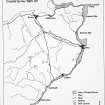Ackergill Mound
Cairn (Period Unassigned)
Site Name Ackergill Mound
Classification Cairn (Period Unassigned)
Alternative Name(s) Wic 132
Canmore ID 9244
Site Number ND35SW 13
NGR ND 3487 5437
Datum OSGB36 - NGR
Permalink http://canmore.org.uk/site/9244
- Council Highland
- Parish Wick
- Former Region Highland
- Former District Caithness
- Former County Caithness
ND35SW 13 3487 5437
(ND 3487 5437) Cairn (NR)
OS 6" map, (1968).
A leaf-shaped spearhead, broken, an imperfect leaf-shaped arrowhead, a barbed arrowhead, and 23 cores, scrapers and chips of flint, all from this cairn, were presented by the representatives of the late Sir Francis Tress Barry to the National Museum of Antiquities of Scotland (NMAS) in 1908.
Proc Soc Antiq Scot 1908.
Cairn, Ackergill: The scanty remains of a large cairn show no features of interest or importance, so thoroughly has it been demolished.
RCAHMS 1911.
The remains of this cairn measure overall 28.0 by 21.0m and 2.0m high. It is largely grass-covered, but many large stones protrude. The largest stone visible is a slab 2.1m long by 1.3m wide and 0.1m thick lying on the side of the mound. The top of the cairn has been hollowed by old excavations.
Visited by OS (R D L), 21 April 1963.
A cairn as described in the previous field report.
Visited by OS (N K B), 3 September 1982.
Field Visit (21 April 1963)
The remains of this cairn measure overall 28.0 by 21.0m and 2.0m high. It is largely grass-covered, but many large stones protrude. The largest stone visible is a slab 2.1m long by 1.3m wide and 0.1m thick lying on the side of the mound. The top of the cairn has been hollowed by old excavations.
Visited by OS (R D L) 21 April 1963.
Project (1980 - 1982)
Field Visit (3 September 1982)
A cairn as described in the previous field report.
Visited by OS (N K B) 3 September 1982.


























